This article has been
cited by other articles in ScienceCentral.
Abstract
Purpose
To compare the astigmatic power of toric intraocular lenses (IOLs) obtained from the AcrySof, TECNIS, and iTrace toric calculator in patients with preoperative with-the-rule (WTR) or against-the-rule (ATR) corneal astigmatism.
Materials and Methods
Fifty eyes with cataract and corneal astigmatism greater than 0.75 diopters were enrolled in each group (WTR and ATR). Keratometric values were measured using autokeratometry, an IOLMaster, and an iTrace, which incorporated corneal topography and ray-tracing aberrometry. Based on measured keratometric values, the astigmatic power of each toric IOL was calculated using three toric calculators.
Results
Bland-Altman plots showed good agreement between six pairwise corneal astigmatism values in both groups. The TECNIS calculator tended to suggest a higher astigmatic power of the toric IOL than the AcrySof calculator. With the higher astigmatism and keratometric values from the IOLMaster, in both groups, calculations from the AcrySof and TECNIS calculators resulted in higher calculated astigmatic powers than those from same calculators with autokeratometry-measured values, demonstrating good agreement. With the higher calculated astigmatic power values, the values from the iTrace toric calculator using keratometric values obtained from iTrace ray tracing wavefront aberrometry or iTrace simulated keratometry showed fair to moderate agreement with those from the other calculator-keratometry pairs in both groups.
Conclusion
To achieve the best refractive outcome after toric IOL implantation, understanding the differences in keratometric values between instruments and in calculated astigmatic power among toric calculator programs is necessary. Moreover, systemic analysis of each toric calculator in conjunction with postoperative data is required.
Keywords: Astigmatic power, toric IOL, toric calculator, corneal astigmatism, keratometry
INTRODUCTION
It has been estimated that 15% to 29% of cataract patients have more than 1.25 diopters (D) of preexisting corneal astigmatism and approximately 10% have 2.00 D or higher.
123 The reduction of refractive astigmatism after cataract surgery can result in a significant improvement of visual quality, whereas remaining astigmatisms decrease visual acuity and the quality of vision.
456 Toric intraocular lens (IOL) implantation allows better management of corneal astigmatism, leading to better uncorrected visual acuity.
78
For surgical corrections of astigmatism with a toric IOL, accurate and reproducible preoperative measurements of corneal astigmatism and proper calculation of the astigmatic power of the toric IOL (toricity) are mandatory. Currently, many types of monofocal toric IOL models are available (
Table 1).
9 Each type of toric IOL is made of different materials and has different asphericity, toricity distribution, morphology, overall diameter, and calculation algorithms.
The AcrySof Toric IOL (Alcon Laboratories, Fort Worth, TX, USA) was introduced in 2005, and the toricity was subjoined to the posterior surface of the IOL. The company provides an online toric calculator for the AcrySof Toric IOL. This calculation program requires input values for preoperative corneal astigmatism, surgically-induced astigmatism (SIA), and incision location. The TECNIS Toric IOL (Abbott Medical Optics, Santa Ana, CA, USA), with an anterior toric aspheric surface, has been recently introduced. Preoperative measurements are also needed to use the online toric calculator for the TECNIS Toric IOL, which is provided by the same company. The cylinder power at the IOL plane of the HOYA iSert Toric IOL (HOYA Surgical Optics, Chino Hills, CA, USA) ranges from 1.50 to 6.00 D, which corresponds to a range from 1.03 to 4.50 D of the corneal plane. Recently, the HOYA iTrace Surgical Workstation (HOYA Surgical Optics) recommended the iTrace toric calculator module, which integrates the HOYA toric calculator, SIA analysis, and the Zaldivar toric caliper, for simulating toric IOL implantation procedures. Thus, astigmatic power can be calculated using the iTrace toric calculator based on the keratometric values measured by iTrace ray tracing wavefront aberrometry or iTrace simulated keratometry automatically.
Comparing the astigmatic power of different toric IOLs using various toric calculators on the same eye can give us clues to understanding the trends of current toric calculator systems. Therefore, the purpose of our study was to compare the astigmatic power of toric IOLs determined using the AcrySof, TECNIS, and iTrace toric calculators in a group of patients with preoperative with-the-rule (WTR) or against-the-rule (ATR) corneal astigmatism.
MATERIALS AND METHODS
This study was approved by the Institutional Review Board of Severance Hospital and conducted according to the tenets of the Declaration of Helsinki and Good Clinical Practices. All patients gave informed consent for participation in the study. Patients who underwent cataract removal by phacoemulsification were included. Preoperative measurements of corneal astigmatism with autokeratometry (KR-7100; Topcon, Tokyo, Japan) were performed, and patients with corneal astigmatism greater than 0.75 D were enrolled. The TECNIS Toric IOL and its calculator are available with a cylinder power of lower than +4.00 D of the IOL plane (lens model ZCT 400), which is designed to correct 2.74 D at the corneal plane. Therefore, patients with more than 2.74 D of corneal astigmatism from autokeratometry were excluded. Other exclusion criteria were a history of intraocular or corneal surgery and ocular trauma, biomicroscopic evidence of corneal disease that could affect corneal astigmatism, and contact lens wearers. Corneal astigmatism was defined as WTR when the steep corneal curvature was within 30 degrees of the vertical meridian and as ATR when the steep corneal curvature was within 30 degrees of the horizontal meridian.
10 The patients who met all criteria were enrolled until 50 eyes were included in each of the two groups.
Measurements
The amount of corneal astigmatism, keratometric values (K), and meridian location were measured using autokeratometry, IOLMaster partial coherence interferometry (Carl Zeiss Meditec, Dublin, CA, USA), and iTrace incorporating corneal topography and ray tracing aberrometry (Tracey Technologies, Houston, TX, USA). Previous studies assessed the repeatability of the keratometric values obtained from these three devices and found that the keratometric measurements were highly correlated between devices and reproducible.
111213 In this study, all measurements were performed by the same operator, who was experienced in the use of all devices. To avoid bias, each of the measurements with the three devices was performed in the same order. Measurements were performed using autokeratometry, the IOLMaster, and then iTrace corneal topography-ray tracing aberrometry, in that order.
For performing astigmatic power calculations of toric IOL with the online AcrySof and TECNIS calculators, keratometric values (steep K, flat K, and their corresponding axes), SIA, incision location, and spherical power of the IOL were required. Autokeratometry and the IOLMaster used a refractive index of 1.3375 to convert the anterior radius of curvature into refractive power measured in diopters. Likewise, 1.3375 was used as the refractive index of the TECNIS calculator. The spherical power of the IOL was chosen on the basis of keratometric values and axial length measurement using the IOLMaster and the SRK/T (Sanders-Retzlaff-Kraff/Theoretical) formula. The depth of the anterior chamber was measured using the IOLMaster. An SIA of 0.5, which was suggested as the default value by the manufacturer, and 0 and 90 degrees of incision location in both the WTR and ATR groups were specified consistently for all calculators.
Table 1 shows the three toric IOLs and their cylinder powers for the IOL plane and corneal plane. The model names of the AcrySof Toric IOL are similar to those of the HOYA iSert Toric IOL. These two toric IOLs are available from T3 to T9 for correction of corneal astigmatism up to 4.00 D. However, the TECNIS Toric IOL uses different lens model names, and its cylinder power on the corneal plane is up to 3.00 D. Therefore, we substituted the names ZCT 150, 225, 300, and 400 of the TECNIS Toric IOL with 3, 4, 5, and 6 for reasonable comparisons among the three toric IOLs.
Statistical analysis
Mann-Whitney U tests were used to determine the difference in corneal astigmatism between the WTR and ATR groups after the Kolmogrov-Smirnov test was performed. Wilcoxon signed ranks tests were used to compare the corneal astigmatism between devices and the astigmatic power of the toric IOL between calculators in each group. The intraclass correlation coefficients (ICCs) were calculated with a two-way random model to assess the agreement between corneal astigmatism from each device in both groups. As there were four keratometric devices, this resulted in six pairwise corneal astigmatism values in each group. For interpreting the strength of agreement based on ICC, an agreement of >0.75 was good, 0.50-0.75 was moderate, and <0.50 was poor. The clinically relevant magnitude of the difference between devices was evaluated by Bland-Altman plots. The 95% limits of agreement (LoA) were calculated as the mean difference ±1.96 standard deviation (SD). Weighted kappa statistics were used to assess the agreement in the calculated astigmatic power of each toric IOL (15 pairs: toric calculator-keratometry vs. toric calculator-keratometry). The iTrace toric calculator was expected to match the keratometric values measured by iTrace ray tracing wavefront aberrometry or iTrace simulated keratometry. The schema of Landis and Koch
14 was used to interpret the strength of agreement based on kappa values, with an agreement of >0.80 as almost perfect, 0.61-0.80 as substantial, 0.41-0.60 as moderate, 0.21-0.40 as fair, and <0.20 as poor.
Statistical analysis was performed using SAS software (version 9.2; SAS Institute, Inc., Cary, NC, USA). Differences were considered statistically significant when p values were less than 0.05.
RESULTS
One hundred eyes of 100 patients were included in the study. Patients' characteristics are summarized in
Table 2. The mean age was significantly higher in the ATR group (
p=0.002). The mean corneal astigmatism values measured with the IOLMaster were significantly higher in the ATR group than in the WTR group (
p=0.040). The mean corneal astigmatism values measured with the IOLMaster were significantly higher than those measured with the other devices in each group (
Table 3). The agreement between all pairwise corneal astigmatism values resulted in good reliability in the WTR group (
Table 3). In the ATR group, the corneal astigmatism values measured using the IOLMaster were in moderate agreement with those measured using the other devices. The comparisons between the other three devices, excluding the IOLMaster, showed good agreement.
The differences of corneal astigmatism values between devices were calculated and plotted against the mean corneal astigmatism value of the two devices (
Fig. 1). The 95% LoA and SD of the difference between iTrace ray tracing wavefront aberrometry and iTrace simulated keratometry were lower than those for other pairs, with the highest ICC in both groups (
Table 3,
Fig. 1).
Table 4 and
Fig. 2 show the results of comparisons of the calculated astigmatic power of toric IOLs among 15 pairs of each group. The TECNIS calculator showed a higher calculated astigmatic power than the AcrySof calculator with keratometric values measured by the same device in both groups (weighted kappa range, 0.613 to 0.677 in the WTR group and 0.494 to 0.519 in the ATR group). In both groups, calculations from the AcrySof and TECNIS calculators using the higher astigmatic values of the IOLMaster showed a higher calculated astigmatic power than those from same calculators using autokeratometry-measured values, demonstrating good agreements (weighted kappa range, 0.879 to 0.948 in the WTR group and 0.820 to 0.857 in the ATR group).
The iTrace calculator with keratometric values measured from iTrace ray tracing wavefront aberrometry or iTrace simulated keratometry showed the higher calculated astigmatic power; however, these values demonstrated fair to moderate agreement with values from the other calculator-keratometry pairs in both groups (weighted kappa range, 0.329 to 0.485 in the WTR group and 0.388 to 0.632 in the ATR group).
DISCUSSION
Recently, one study reported that the distribution of corneal astigmatism measured using the IOLMaster device before cataract surgery showed a tendency for corneal astigmatism, especially ATR astigmatism, to increase with age.
15 Consistently, our results demonstrated that the ATR group had a relatively older age and significantly higher corneal astigmatism values obtained from the IOLMaster than the WTR group.
Although showing moderate to good agreement, the IOLMaster provided steeper keratometric values than autokeratometry and the iTrace device in both groups. In other words, the corneal astigmatism values measured from the IOLMaster were higher than those measured from autokeratometry and the iTrace device. According to previous reports, the IOLMaster tended to give the greatest values for astigmatism, which was consistent with our findings.
1213 Thus, we confirmed that the IOLMaster has a tendency to provide a higher corneal astigmatism value than other keratometry devices for both ATR and WTR astigmatism.
The astigmatic power of toric IOL is chosen based on the amount of corneal astigmatism determined using a calculation program provided by manufacturer, which indicates that each calculator has been originally invented for its own company's toric IOL.
16 Therefore, without considering the characteristics of toric IOLs, direct comparison of the astigmatic power calculated from different calculators is inappropriate. Nevertheless, we sought to find the tendencies of each calculator rather than simply comparing them. In this study, despite identical keratometric values and other required input, the TECNIS calculator tended to suggest higher astigmatic power of toric IOLs than the AcrySof calculator. The toric IOL model that offers the lowest amount of residual astigmatism without flipping the meridian was chosen in both the TECNIS and AcrySof calculators. However, the TECNIS calculator also presents the astigmatic power of toric IOL that has the minimal anticipated residual astigmatism after IOL implantation, despite the fact that the meridian of residual astigmatism changes to the opposite direction from the toric IOLmeridian of placement. On the contrary, the AcrySof calculator suggests the astigmatic power with anticipated residual astigmatism remaining minimally, without changing the meridian of original corneal astigmatism. Thus, even if a larger residual astigmatism is anticipated, the AcrySof calculator could provide a lower astigmatic power for a toric IOL than the TECNIS calculator.
Additionally, the ratio of the astigmatic power between the IOL plane and corneal plane was influenced by keratometric values and axial length, as the anterior chamber depth varied according to the change of those factors. The TECNIS calculator considers anterior chamber depth on the basis of the axial length and keratometric values to calculate the astigmatic power of the toric IOL. However, the AcrySof and iTrace calculators do not take these values into account when performing the same calculations.
1718 Instead, these calculators use a constant for the ratio between the cylinder power in the IOL plane and that in the corneal plane; thus, the IOL suggested by these calculators might result in undercorrection or overcorrection according to changes of the keratometric values and axial length. This may contribute to the difference of the suggested astigmatic power of the toric IOL between the TECNIS and AcrySof calculators.
Corneal astigmatism values from iTrace ray tracing wavefront aberrometry had excellent agreement with those from iTrace simulated keratometry. However, there was a tendency of higher corneal astigmatism and astigmatic power of the toric IOL in iTrace ray tracing wavefront aberrometry, compared with iTrace simulated keratometry. The former provides measurements of the entire area of the cornea relative to pupil diameter; in contrast, the latter only provides information at the 3.00 mm annular zone. Moreover, although the former takes measurements by projecting a near-beam into the eye using a laser ray tracing method, the latter measures corneal power simply based on the analysis of a placido ring generated by corneal topography.
In this study, the iTrace calculator, even with lower corneal astigmatism values than the IOLMaster, showed a tendency towards a higher astigmatic power of the toric IOL than the AcrySof and TECNIS calculators. The AcrySof and TECNIS calculators determine the astigmatic power based on keratometric values measured from autokeratometry or the IOLMaster, which reflects anterior corneal astigmatism only. In contrast, the iTrace device may calculate total corneal power and total corneal astigmatism by implementing the ray-tracing method. However, we are limited in providing a rational explanation for the likely discrepancy between the lower corneal astigmatism values and higher calculated astigmatic power, as each company did not provide their calculation formula and variables for their own calculator in detail.
The major limitation of this study is its lack of postoperative objective and subjective refractive results following toric IOL implantation. One of the most effective ways for evaluating the accuracy or superiority of each calculator might be to compare the postoperative surgical outcomes of the accuracy of corneal astigmatism correction. However, it is difficult to compare the clinical outcome of each calculator system practically, given that implantation of three different toric IOLs based on each calculator in the same eye is infeasible. In addition to preoperative analysis of corneal astigmatism and astigmatic power calculation, various steps including horizontal marking, corneal incision, toric IOL alignment, and wound closure can contribute to the postoperative refractive outcomes. For these reasons, we focused on analyzing the pattern of suggested astigmatic power of each calculator.
In conclusion, the IOLMaster suggests a higher astigmatism power of each toric IOL when using the AcrySof and TECNIS calculators in the WTR and ATR groups. The TECNIS calculator tended to suggest a higher astigmatic power of toric IOL than the AcrySof calculator. Additionally, the iTrace calculator was found to suggest a higher astigmatism power, despite the lower corneal astigmatism values in both groups. We expect that such information can help cataract surgeons understand the pattern of the suggested astigmatic power of each calculator when planning toric IOL implantation.
ACKNOWLEDGEMENTS
This work was partially supported by a National Research Foundation of Korea (NRF) grant funded by the Korean government (MEST No. 2013R1A1A2058907).
References
1. Hoffer KJ. Biometry of 7,500 cataractous eyes. Am J Ophthalmol. 1980; 90:360–368. PMID:
7425052.

2. Hoffmann PC, Hütz WW. Analysis of biometry and prevalence data for corneal astigmatism in 23,239 eyes. J Cataract Refract Surg. 2010; 36:1479–1485. PMID:
20692558.
3. Ferrer-Blasco T, Montés-Micó R, Peixoto-de-Matos SC, González-Méijome JM, Cerviño A. Prevalence of corneal astigmatism before cataract surgery. J Cataract Refract Surg. 2009; 35:70–75. PMID:
19101427.

4. Wolffsohn JS, Bhogal G, Shah S. Effect of uncorrected astigmatism on vision. J Cataract Refract Surg. 2011; 37:454–460. PMID:
21333869.

5. Visser N, Bauer NJ, Nuijts RM. Residual astigmatism following toric intraocular lens implantation related to pupil size. J Refract Surg. 2012; 28:729–732. PMID:
22978297.

6. Guo H, Atchison DA. Subjective blur limits for cylinder. Optom Vis Sci. 2010; 87:E549–E559. PMID:
20562670.

7. Hayashi K, Kondo H, Yoshida M, Manabe S, Hirata A. Higher-order aberrations and visual function in pseudophakic eyes with a toric intraocular lens. J Cataract Refract Surg. 2012; 38:1156–1165. PMID:
22608030.

8. Scialdone A, Raimondi G, Monaco G. In vivo assessment of higher-order aberrations after AcrySof toric intraocular lens implantation: a comparative study. Eur J Ophthalmol. 2012; 22:531–540. PMID:
22139617.

9. Savini G, Barboni P, Parisi V, Carbonelli M. The influence of axial length on retinal nerve fibre layer thickness and optic-disc size measurements by spectral-domain OCT. Br J Ophthalmol. 2012; 96:57–61. PMID:
21349942.

10. Ernest P, Potvin R. Effects of preoperative corneal astigmatism orientation on results with a low-cylinder-power toric intraocular lens. J Cataract Refract Surg. 2011; 37:727–732. PMID:
21333485.

11. Shirayama M, Wang L, Weikert MP, Koch DD. Comparison of corneal powers obtained from 4 different devices. Am J Ophthalmol. 2009; 148:528–535. PMID:
19541287.

12. Lee H, Chung JL, Kim EK, Sgrignoli B, Kim TI. Univariate and bivariate polar value analysis of corneal astigmatism measurements obtained with 6 instruments. J Cataract Refract Surg. 2012; 38:1608–1615. PMID:
22795977.

13. Wang Q, Savini G, Hoffer KJ, Xu Z, Feng Y, Wen D, et al. A comprehensive assessment of the precision and agreement of anterior corneal power measurements obtained using 8 different devices. PLoS One. 2012; 7:e45607. PMID:
23049823.

14. Landis JR, Koch GG. The measurement of observer agreement for categorical data. Biometrics. 1977; 33:159–174. PMID:
843571.

15. Chen W, Zuo C, Chen C, Su J, Luo L, Congdon N, et al. Prevalence of corneal astigmatism before cataract surgery in Chinese patients. J Cataract Refract Surg. 2013; 39:188–192. PMID:
23141077.

16. Visser N, Bauer NJ, Nuijts RM. Toric intraocular lenses: historical overview, patient selection, IOL calculation, surgical techniques, clinical outcomes, and complications. J Cataract Refract Surg. 2013; 39:624–637. PMID:
23522584.

17. Savini G, Hoffer KJ, Ducoli P. A new slant on toric intraocular lens power calculation. J Refract Surg. 2013; 29:348–354. PMID:
23659233.

18. Goggin M, Moore S, Esterman A. Outcome of toric intraocular lens implantation after adjusting for anterior chamber depth and intraocular lens sphere equivalent power effects. Arch Ophthalmol. 2011; 129:998–1003. PMID:
21825183.

Fig. 1
Bland-Altman plots showing differences in corneal astigmatism between devices in WTR and ATR groups. The mean difference is represented by the horizontal solid line, and 95% limits of agreement are represented by dotted lines. (A) Autokeratometry vs. IOLMaster partial coherence interferometry. (B) Autokeratometry vs. iTrace ray tracing wavefront aberrometry. (C) Autokeratometry vs. iTrace simulated keratometry. (D) IOLMaster partial coherence interferometry vs. iTrace ray tracing wavefront aberrometry. (E) IOLMaster partial coherence interferometry vs. iTrace simulated keratometry. (F) iTrace ray tracing wavefront aberrometry vs. iTrace simulated keratometry. WTR, with-the-rule; ATR, against-the-rule.
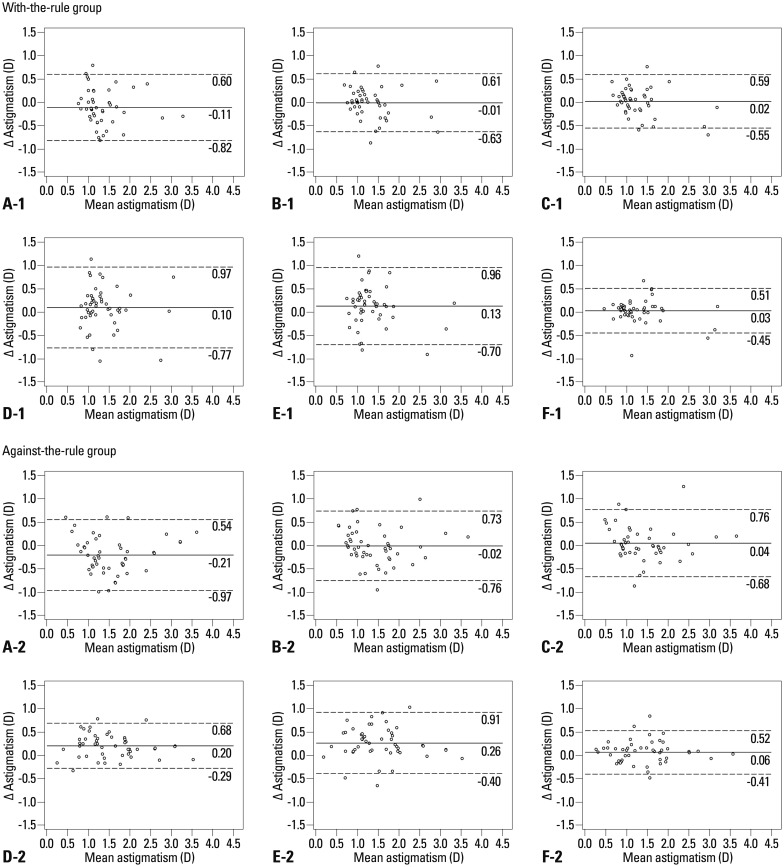
Fig. 2
Agreement in calculated astigmatic power of toric intraocular lenses. Weighted kappa statistics values and corresponding 95% confidence intervals for agreement in calculated astigmatic power of toric intraocular lenses among 15 toric calculator-keratometry pairs in WTR and ATR groups are shown. AcrySof, AcrySof toric calculator; TECNIS, TECNIS toric calculator; iTrace, iTrace toric calculator; Auto, autokeratometry; IOLM, IOLMaster partial coherence interferometry; iTrace WF, iTrace ray tracing wavefront aberrometry; iTrace Sim, iTrace simulated keratometry.
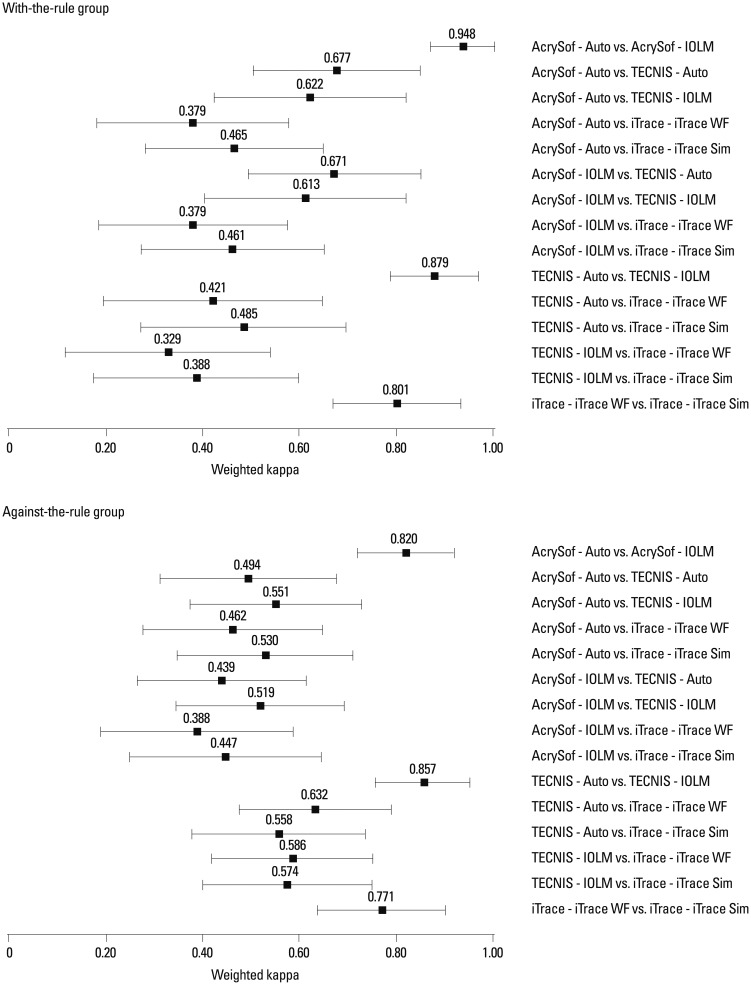
Table 1
Astigmatic Power Options of Three Toric Intraocular Lenses
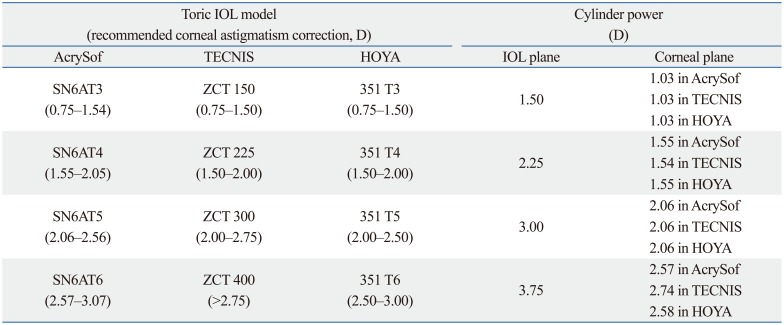
|
Toric IOL model (recommended corneal astigmatism correction, D) |
Cylinder power (D) |
|
AcrySof |
TECNIS |
HOYA |
IOL plane |
Corneal plane |
|
SN6AT3 (0.75-1.54) |
ZCT 150 (0.75-1.50) |
351 T3 (0.75-1.50) |
1.50 |
1.03 in AcrySof |
|
1.03 in TECNIS |
|
1.03 in HOYA |
|
SN6AT4 (1.55-2.05) |
ZCT 225 (1.50-2.00) |
351 T4 (1.50-2.00) |
2.25 |
1.55 in AcrySof |
|
1.54 in TECNIS |
|
1.55 in HOYA |
|
SN6AT5 (2.06-2.56) |
ZCT 300 (2.00-2.75) |
351 T5 (2.00-2.50) |
3.00 |
2.06 in AcrySof |
|
2.06 in TECNIS |
|
2.06 in HOYA |
|
SN6AT6 (2.57-3.07) |
ZCT 400 (>2.75) |
351 T6 (2.50-3.00) |
3.75 |
2.57 in AcrySof |
|
2.74 in TECNIS |
|
2.58 in HOYA |
Table 2
Preoperative Patient Characteristics
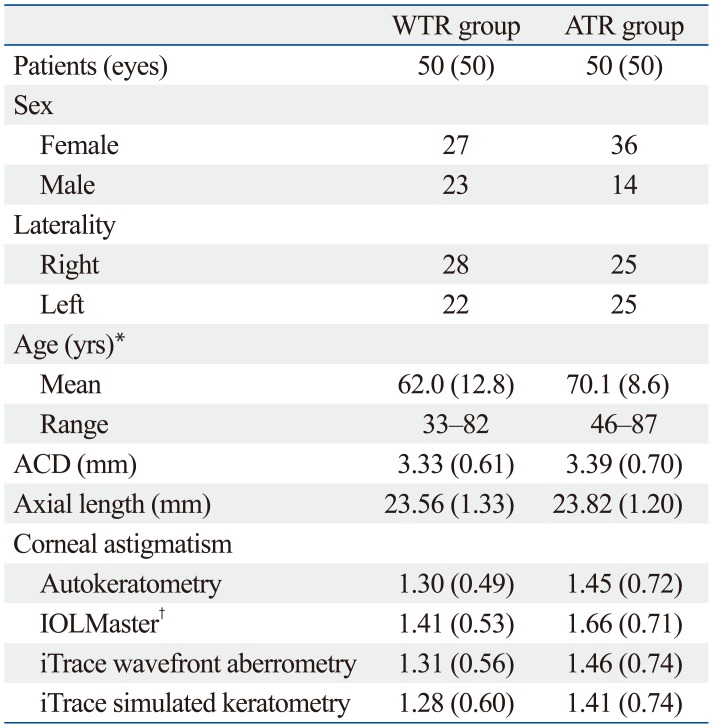
|
WTR group |
ATR group |
|
Patients (eyes) |
50 (50) |
50 (50) |
|
Sex |
|
|
|
Female |
27 |
36 |
|
Male |
23 |
14 |
|
Laterality |
|
|
|
Right |
28 |
25 |
|
Left |
22 |
25 |
|
Age (yrs)*
|
|
|
|
Mean |
62.0 (12.8) |
70.1 (8.6) |
|
Range |
33-82 |
46-87 |
|
ACD (mm) |
3.33 (0.61) |
3.39 (0.70) |
|
Axial length (mm) |
23.56 (1.33) |
23.82 (1.20) |
|
Corneal astigmatism |
|
|
|
Autokeratometry |
1.30 (0.49) |
1.45 (0.72) |
|
IOLMaster†
|
1.41 (0.53) |
1.66 (0.71) |
|
iTrace wavefront aberrometry |
1.31 (0.56) |
1.46 (0.74) |
|
iTrace simulated keratometry |
1.28 (0.60) |
1.41 (0.74) |
Table 3
Comparison of Corneal Astigmatism Measurements between Devices
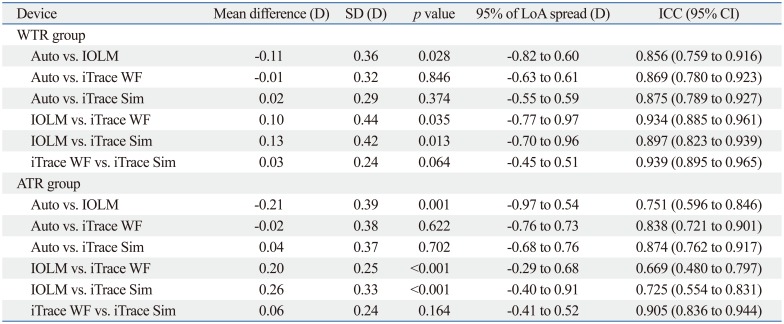
|
Device |
Mean difference (D) |
SD (D) |
p value |
95% of LoA spread (D) |
ICC (95% CI) |
|
WTR group |
|
|
|
|
|
|
Auto vs. IOLM |
-0.11 |
0.36 |
0.028 |
-0.82 to 0.60 |
0.856 (0.759 to 0.916) |
|
Auto vs. iTrace WF |
-0.01 |
0.32 |
0.846 |
-0.63 to 0.61 |
0.869 (0.780 to 0.923) |
|
Auto vs. iTrace Sim |
0.02 |
0.29 |
0.374 |
-0.55 to 0.59 |
0.875 (0.789 to 0.927) |
|
IOLM vs. iTrace WF |
0.10 |
0.44 |
0.035 |
-0.77 to 0.97 |
0.934 (0.885 to 0.961) |
|
IOLM vs. iTrace Sim |
0.13 |
0.42 |
0.013 |
-0.70 to 0.96 |
0.897 (0.823 to 0.939) |
|
iTrace WF vs. iTrace Sim |
0.03 |
0.24 |
0.064 |
-0.45 to 0.51 |
0.939 (0.895 to 0.965) |
|
ATR group |
|
|
|
|
|
|
Auto vs. IOLM |
-0.21 |
0.39 |
0.001 |
-0.97 to 0.54 |
0.751 (0.596 to 0.846) |
|
Auto vs. iTrace WF |
-0.02 |
0.38 |
0.622 |
-0.76 to 0.73 |
0.838 (0.721 to 0.901) |
|
Auto vs. iTrace Sim |
0.04 |
0.37 |
0.702 |
-0.68 to 0.76 |
0.874 (0.762 to 0.917) |
|
IOLM vs. iTrace WF |
0.20 |
0.25 |
<0.001 |
-0.29 to 0.68 |
0.669 (0.480 to 0.797) |
|
IOLM vs. iTrace Sim |
0.26 |
0.33 |
<0.001 |
-0.40 to 0.91 |
0.725 (0.554 to 0.831) |
|
iTrace WF vs. iTrace Sim |
0.06 |
0.24 |
0.164 |
-0.41 to 0.52 |
0.905 (0.836 to 0.944) |
Table 4
Comparison of Calculated Astigmatic Power of Toric Intraocular Lens
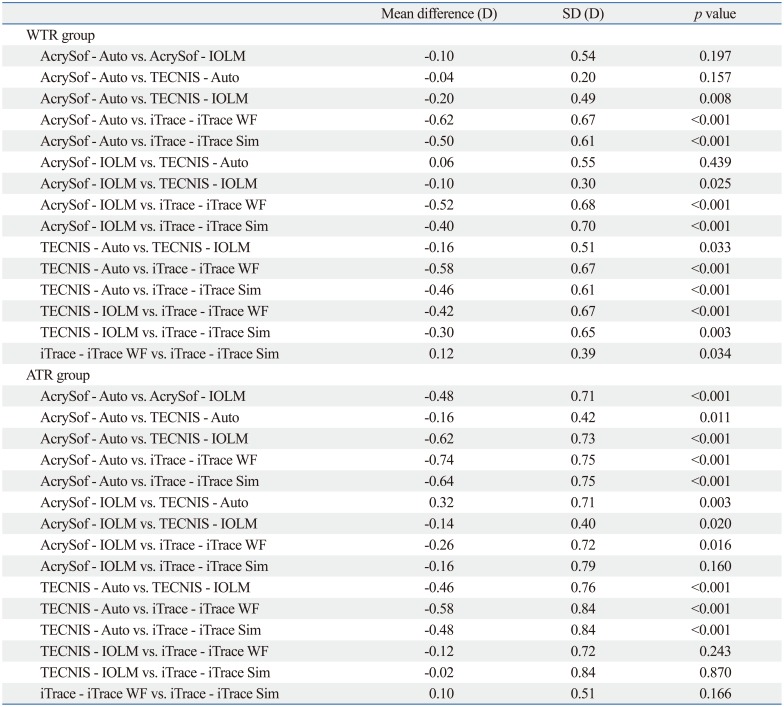
|
Mean difference (D) |
SD (D) |
p value |
|
WTR group |
|
|
|
|
AcrySof - Auto vs. AcrySof - IOLM |
-0.10 |
0.54 |
0.197 |
|
AcrySof - Auto vs. TECNIS - Auto |
-0.04 |
0.20 |
0.157 |
|
AcrySof - Auto vs. TECNIS - IOLM |
-0.20 |
0.49 |
0.008 |
|
AcrySof - Auto vs. iTrace - iTrace WF |
-0.62 |
0.67 |
<0.001 |
|
AcrySof - Auto vs. iTrace - iTrace Sim |
-0.50 |
0.61 |
<0.001 |
|
AcrySof - IOLM vs. TECNIS - Auto |
0.06 |
0.55 |
0.439 |
|
AcrySof - IOLM vs. TECNIS - IOLM |
-0.10 |
0.30 |
0.025 |
|
AcrySof - IOLM vs. iTrace - iTrace WF |
-0.52 |
0.68 |
<0.001 |
|
AcrySof - IOLM vs. iTrace - iTrace Sim |
-0.40 |
0.70 |
<0.001 |
|
TECNIS - Auto vs. TECNIS - IOLM |
-0.16 |
0.51 |
0.033 |
|
TECNIS - Auto vs. iTrace - iTrace WF |
-0.58 |
0.67 |
<0.001 |
|
TECNIS - Auto vs. iTrace - iTrace Sim |
-0.46 |
0.61 |
<0.001 |
|
TECNIS - IOLM vs. iTrace - iTrace WF |
-0.42 |
0.67 |
<0.001 |
|
TECNIS - IOLM vs. iTrace - iTrace Sim |
-0.30 |
0.65 |
0.003 |
|
iTrace - iTrace WF vs. iTrace - iTrace Sim |
0.12 |
0.39 |
0.034 |
|
ATR group |
|
|
|
|
AcrySof - Auto vs. AcrySof - IOLM |
-0.48 |
0.71 |
<0.001 |
|
AcrySof - Auto vs. TECNIS - Auto |
-0.16 |
0.42 |
0.011 |
|
AcrySof - Auto vs. TECNIS - IOLM |
-0.62 |
0.73 |
<0.001 |
|
AcrySof - Auto vs. iTrace - iTrace WF |
-0.74 |
0.75 |
<0.001 |
|
AcrySof - Auto vs. iTrace - iTrace Sim |
-0.64 |
0.75 |
<0.001 |
|
AcrySof - IOLM vs. TECNIS - Auto |
0.32 |
0.71 |
0.003 |
|
AcrySof - IOLM vs. TECNIS - IOLM |
-0.14 |
0.40 |
0.020 |
|
AcrySof - IOLM vs. iTrace - iTrace WF |
-0.26 |
0.72 |
0.016 |
|
AcrySof - IOLM vs. iTrace - iTrace Sim |
-0.16 |
0.79 |
0.160 |
|
TECNIS - Auto vs. TECNIS - IOLM |
-0.46 |
0.76 |
<0.001 |
|
TECNIS - Auto vs. iTrace - iTrace WF |
-0.58 |
0.84 |
<0.001 |
|
TECNIS - Auto vs. iTrace - iTrace Sim |
-0.48 |
0.84 |
<0.001 |
|
TECNIS - IOLM vs. iTrace - iTrace WF |
-0.12 |
0.72 |
0.243 |
|
TECNIS - IOLM vs. iTrace - iTrace Sim |
-0.02 |
0.84 |
0.870 |
|
iTrace - iTrace WF vs. iTrace - iTrace Sim |
0.10 |
0.51 |
0.166 |










 PDF
PDF ePub
ePub Citation
Citation Print
Print


 XML Download
XML Download